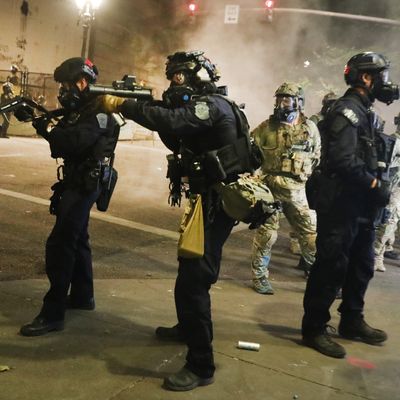
In his announcement last week that he was considering sending in federal agents to more American cities, President Trump praised the “fantastic job” that militarized officers had done in Portland protecting federal property, tear-gassing veterans, and detaining demonstrators in unmarked vehicles. While the president has administration officials including Department of Homeland Security Acting Secretary Chad Wolf and Attorney General William Barr cooperating with his law-and-order push, the New York Times reports that some federal law enforcement agencies have also been yearning to join the cause since the early days of unrest.
FBI deputy director David L. Bowdich shared a particular enthusiasm for joining the effort to clear city streets of mostly non-violent protestors. In a June 2 memo, Bowdich wrote that “When 9/11 occurred, our folks did not quibble about whether there was danger ahead for them. They ran head-on into peril.” He also called for investigations into protest leaders using “robust social media exploitation teams.”
FBI investigations into protest movements certainly have not painted the bureau in a positive light in the past. But neither does Bowdich’s memo implicitly comparing the peril that federal agents faced in a terrorist attack that killed almost 3,000 Americans to massive, largely peaceful demonstrations by Americans. It does, however, suggest that FBI brass thinks highly of the president’s opinion that protestors are “thugs” to be fought back with “the most vicious dogs, and most ominous weapons.”
The Times also obtained a remarkable internal memo from Department of Homeland Security Intelligence officers:
Domestic intelligence agents are uncertain about the root causes of [the continued unrest]. Another internal government memo, from Department of Homeland Security intelligence officers, indicated that even as federal agents in camouflage deployed to quell the unrest in Portland, the administration had little understanding of what it was facing.
The memo tried to put the recent conflict into historical context, describing how “anarchist extremists” have committed crimes in the Pacific Northwest for years and asserting that “sustained violence against government personnel and facilities” had longstanding roots.
But even as it laid out a timeline of violence extending back to 2015, the intelligence briefing, dated July 16, admitted, “We have low confidence in our assessment” when it comes to the present day.
“We lack insight into the motives for the most recent attacks,” it read.
That domestic intelligence agents were unable to determine that protests against police brutality escalated following high-profile instances of police brutality suggests a severe misunderstanding of the situation on the ground, if not a need for new intelligence. But outside the administration, the situation is a little clearer. “They’ve become the story,” John Sandweg, a former acting general counsel for the Department of Homeland Security, told the New York Times, of the deployment of federal agents. “The protests are feeding off their presence.”
With federal officials now in cities including Chicago and New York, the phenomenon doesn’t appear to be subsiding anytime soon: On Tuesday, videos circulated of officers in in Manhattan detaining a protester in an unmarked minivan, though it was unclear what agency the plainclothes officials were affiliated with.






























